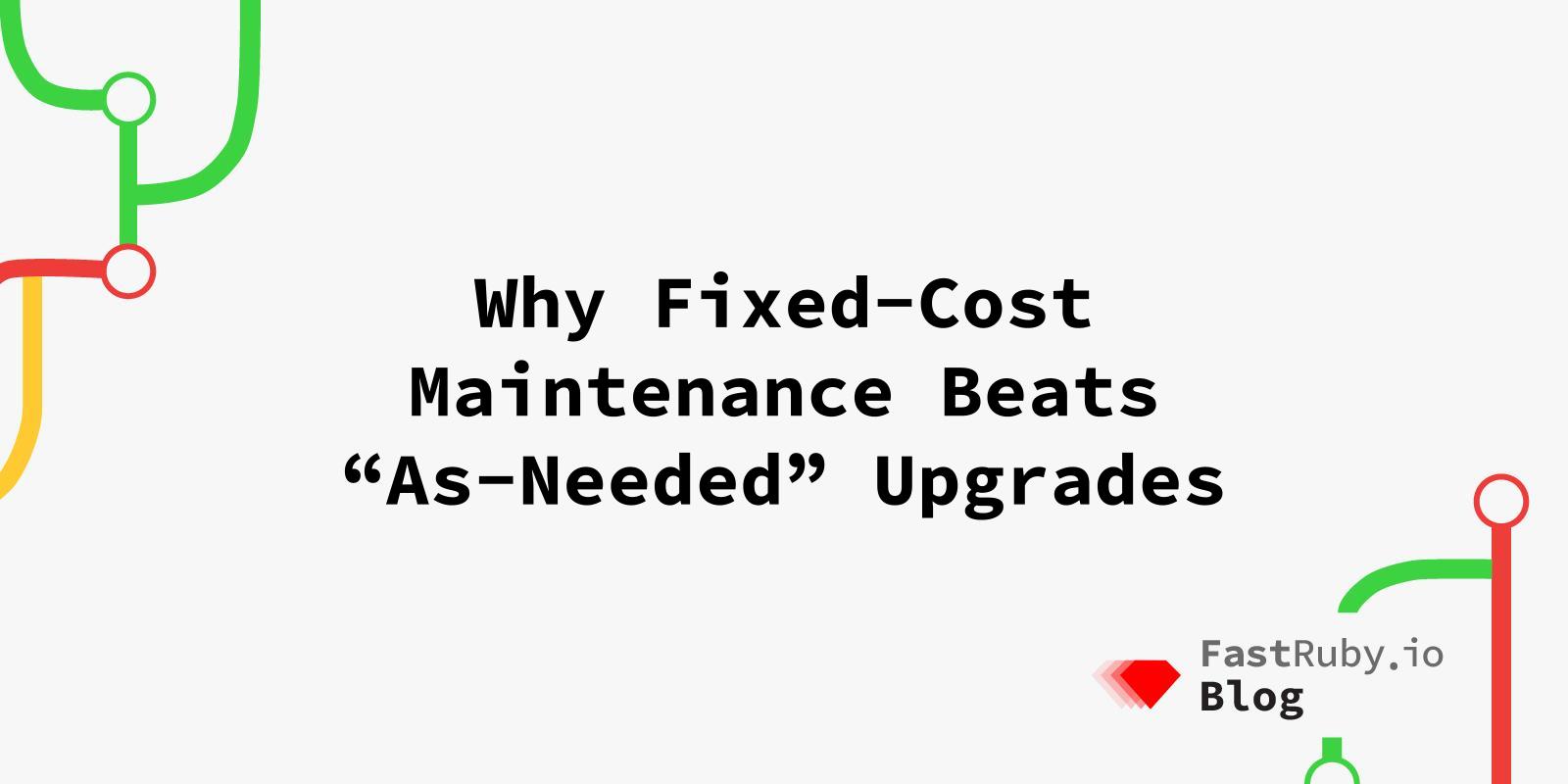
Why Fixed-Cost Maintenance Beats “As-Needed” Upgrades
Maintaining a Ruby on Rails application often slips down the priority list. Everything seems fine, until suddenly it isn’t. A gem update breaks a feature, a security flaw makes headlines, or your app refuses to deploy after a server upgrade. When that happens, teams scramble to find help, often at the worst possible time. This “as-needed” upgrading approach may appear cost-effective in the short term, but it leads to stress, downtime, and unpredictable expenses.
But there is a smarter path forward: fixed-cost monthly maintenance . In this post, you’ll see why investing in a maintenance retainer is better than reactive upgrades, and how our service delivers value month after month.
The Cost of Upgrading As Needed
Reactive maintenance is painfully expensive, and not just in dollars. Here’s how it drains your organization:
- Unpredictable costs: Emergency upgrades, rushed patches, and crisis consulting fees often balloon far beyond original estimates. You end up with budget spikes that derail financial planning and upset stakeholders.
- Lost productivity: Developers must abandon feature work and scramble to fix urgent issues. Teams miss deadlines, users don’t see updates, and morale suffers.
- Increased risk: As technical debt builds and dependencies fall behind, your system becomes fragile. That fragility opens the door to outages, data corruption, and security breaches, each of which is far more costly than proactive care.
In short: “as-needed” upgrades distract you from your mission and expose you to unnecessary risk. But it doesn’t have to be this way. Fixed-cost maintenance allows you to stay focused on product, while the upkeep is handled under the hood.
Why Fixed-Cost Maintenance Works
When you shift from reactive to proactive, a lot changes for the better. Here’s what a good maintenance retainer gives you:
- Budget certainty: Pay the same amount each month. No surprise emergency invoices. This gives your finance team predictability and lets you invest elsewhere with confidence.
- Peace of mind: Updates, patches, and fixes happen quietly in the background. No more sleepless nights worrying about whether your next deployment will break. Stakeholders can rest easier knowing your app has active care.
- Incremental, sustainable progress: Over time, small but consistent actions compound: gem upgrades, dependency updates, code cleanup, better tests, and debt reduction. These accumulate into a healthier, more maintainable codebase. A slow and steady approach avoids the shock of huge, risky migrations.
Think of it like preventive healthcare: regular check-ups catch issues before they become emergencies and save you from the hospital.
What Our Fixed-Cost Maintenance Service Includes
At FastRuby.io, our fixed-cost monthly maintenance service ’s focus is on gradual, steady improvement. Here’s how it works and what you get:
How It Works
- Kickoff and discovery: In the first month, we partner with your team to understand your business goals, architecture, and pain points. We audit your codebase and infrastructure to highlight the highest-leverage opportunities.
- Roadmap and prioritization: We co-create a maintenance roadmap consisting of short-term wins and long-term refactors. We balance urgency (security, broken dependencies) with improvement (test coverage, performance).
- Ongoing execution: Each month, we allocate your committed hours to maintenance work. We submit pull requests, discuss changes, and monitor results. Every change is transparent, tested, and reviewed.
What You Get Each Month
Here are the core service areas we cover, and how they benefit your application:
- Ruby upgrades: We help you migrate to newer Ruby versions. We use our proven “dual-booting” technique to ensure your test suite supports both versions before moving forward.
- Rails upgrades: We take a gradual approach to Rails version bumps by creating small, safe PRs that maintain backward compatibility. This helps avoid massive, risky migrations all at once.
- Dependency management: We handle minor and major version upgrades, one gem at a time, with careful testing and rollback paths.
- Performance monitoring: We integrate or configure APM services (e.g. New Relic) if you don’t already have them. Then we track memory, latency, and slow endpoints, and provide you a monthly report on top issues.
- Technical debt management: We monitor code complexity, duplication, churn, and test gaps. Each month, we make focused improvements: refactoring, cleaning up messes, improving architecture so your code becomes easier to understand and extend.
- Security patches: From day one, we assess your application for known vulnerabilities. Every month, we apply patches, update vulnerable dependencies, and maintain a clean security posture.
These aren’t vague promises - we deliver PRs, reports, and measurable changes every month. Plus, you stay in full control: all code changes go through your review, and you can always adjust priorities.
A Tale of Two Teams
Picture two Rails teams:
- Team A waits until the fire starts. Their developers are yanked from feature work to fix production bugs, budgets overshoot, and upgrades become dangerous migrations. Over time, the app becomes brittle and unpredictable.
- Team B invests in fixed-cost maintenance. They put aside a steady budget each month. Gems get updated, dependencies get cleaned, vulnerabilities get patched, and technical debt is chipped away. Their application stays robust, performance improves, and developers focus on delivering new features, not fighting fires.
Which path would you rather take?
Conclusion
Upgrades performed only when needed tend to be reactive, expensive, and high-risk. A fixed-cost maintenance service changes that dynamic: you get stability, predictability, and gradual improvements that safeguard your app and team.
With Bonsai, you gain a maintenance partner who cares about your app’s long-term health. We manage Ruby and Rails upgrades, dependencies, performance, security, and technical debt, all under one predictable monthly cost. You maintain control, visibility, and direction.
Ready to make the switch? Let’s talk .